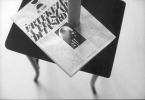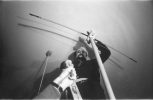György Jovánovics: Construction Pressing into the Ceiling, 1971
Works using “Construction Pressing into the Ceiling”
Klaus Groh, a gallery owner and manager-purveyor of idea art living in Oldenburg (West Germany at the time) once decided to put together and publish a volume about the new creative avantgarde in Eastern Europe, then isolated from the West – even in the physical sense, by the Iron Curtain and mined borders.
That volume was published by the Cologne-based house of Dumont Schauberg in 1972 as part of the “DuMont Aktuell” series that bore the title Contemporary Art in Europe; the book presented work by artists from Czechoslovakia, Yugoslavia, Poland, Romania, and the Soviet Union – three of these being countries that no longer exist.
So I had one page already. Instead of sending three more, I thought it would be more interesting to ask three colleague-friends of mine, also invited by Groh, to employ the device as they saw fit in their own environments. So I took them the camera and the pressing rod.
Miklós Erdély’s arrow wants to fly with double force: the compressed springs only increase the effect of the press contraption. The arrow’s path has three breaks to it. Through the rod, the springs press the middle of the arrow (not the ceiling) upwards, causing the bowstring to be pulled taut downwards, stretched by the arrow’s lower end. The tip of the arrow is up, touching the ceiling at one sole point; its upward path is limited. At the moment of aiming, the arrow is already in its target.
This construction was already in place as Erdély had originally planned, when he had a further idea. A plumb line was quickly rounded up and attached to the tip of the arrow. This weight meant a new line of force: a downward one, reinforcing the ceiling to withstand the doubled force of springs and arrow, lest it be pierced. The photos are by György Erdély.
László Lakner first pressed his palm into the ceiling, then his favorite volume of Lukács, and finally a photo of his hand bound to the Lukács book.
Stjóby: A Molotov cocktail, a cat, a dog, and himself.
(It was no easy task executing this action. The first time around, it didn’t come off at all: the dog and cat were both too wild, and the cat ran away. Zaránd had no time to make a usable picture. It was a good while before Stjóby found new animals. He had neither a cat nor a dog, and the ones we had already used were out of the question. Still, the second time around, everything worked.)
After the 4 pages of photos, I did nothing more with the contraption.
A decade and a half later in May of 1985, two young art historians at the Budapest Galéria, Gábor Andrási and Tamás Török, put on an exhibition called “101 Objects”. They requested the object, which still happened to be around. To my great surprise, they assembled the chair and the table at the same time! (I had not even realized this was possible.) That is how it appeared at the show, and a photo of it appeared on the invitation and poster. Another 15 years later, it was exhibited in Ljubljana, then in Berlin, by yet others.
In 1995, I exhibited a photo of the Stjóby version in the Hungarian Pavilion at the Venice Biennale, as a case study of an artwork that does not have one sole person as creator.
Thirty-six years after it was completed, I myself set it up in its original version.
Budapest, October 2007
György Jovánovics
*Note that Szentjóby’s version describes the Molotov cocktail phenomenon (verbally, in the title) rather than documenting it, as there was in fact no gasoline in the bottle. It did not explode.










